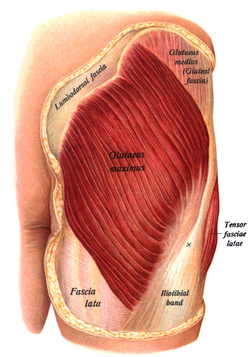Gluteus Maximus: Difference between revisions
No edit summary |
No edit summary |
||
| Line 24: | Line 24: | ||
Inferior Gluteal nerve L5-S2 | Inferior Gluteal nerve L5-S2 | ||
{{#ev:youtube|tA-goIvoAcw}} | Further detailed anatomical description can be found at [http://prohealthsys.com/site/anatomy/grays-anatomy/index-7/index-7-3/index-7-2/muscles_of_the_gluteal_region/ Prohealth (Gray's Anatomy)] | ||
{{#ev:youtube|tA-goIvoAcw}} | |||
== Palpation == | == Palpation == | ||
Revision as of 23:08, 12 March 2015
Original Editor - Joanne Garvey
Top Contributors - George Prudden, Joanne Garvey, Kim Jackson, Ahmed Nasr, Lucinda hampton, Admin, Rachael Lowe, Joao Costa, Khloud Shreif, Richard Benes, Wendy Walker, Evan Thomas, WikiSysop, Sai Kripa, Kai A. Sigel and Candace Goh
Anatomy[edit | edit source]
Origins and Insertions[1]
This powerful muscle has a superficial and deep origin.
Superficial Fibres: Arise from the iliac crest, the posterior superior iliac spine, the thoracolumbar fascia, the cacrum and coccyx.
Deep Fibres: Arise from the Ala of the ilium behind the posterior gluteal line, from the sacrotuberal ligament and fascia of the sacrotuberous ligament and fascia of the gluteus medius (Aponeurosis glutealis).
The proximal part of the muscle inserts into the iliotibial tract.
The distal part inserts into the gluteal tuberosity.
Innervation
Inferior Gluteal nerve L5-S2
Further detailed anatomical description can be found at Prohealth (Gray's Anatomy)
Palpation[edit | edit source]
Please watch the following video to learn about palpation and stretching the gluteus maximus
Function[edit | edit source]
Its primary role is to extend and laterally rotate the hip.
It also prevents excessive anterior rotation of the pelvis and assists with the stability of the sacro-iliac joint by providing force closure for this joint. Gluteus maximus is part of the posterior sling of muscles.
Due to its insertion sites, it is able to act as an abductor as well as an adductor of the hip joint. The part that inserts into the fascia lata abducts, while the fibres that insert into the gluteal tuberosity serve to adduct the hip.
Both glutei maximi may assist in the contraction of the external sphincter ani.
It is particularly active when climbing stairs, or when rising from sitting [2]
Recent research indicates that contraction of the deep abdominal muscles may assist with the contraction of gluteus maximus to assist with the control of anterior pelvic anterior rotation.[3]
Gluteal muscle weakness has been proposed to be associated with a number of lower limb injuries. recent research indicates that effective exercising to specifically target the gluteus maximus muscle is the single leg squat and the singe leg prone dead lift. These exercises elicited the most significant activity in emg when tested against other forms of exercise.[4]
References[edit | edit source]
References will automatically be added here, see adding references tutorial.
- ↑ Kahle W; Color Atlas/Text of human Anatomy, Vol 1; Locomotor System; 4th rev edn; 1992; pg 232
- ↑ Norkin C; Levangie P; Joint Structure and Function: a comprehensive Analysis 2nd Ed; 1992; 320-321
- ↑ Kim TW, Kim YW.Effects of abdominal drawing-in during prone hip extension on the muscle activities of the hamstring, gluteus maximus, and lumbar erector spinae in subjects with lumbar hyperlordosis; J Phys Ther Sci. 2015 Feb;27(2):383-6
- ↑ Distefano LJ, Blackburn JT, Marshall SW, Padua DAGluteal muscle activation during common therapeutic exercises; J Orthop Sports Phys Ther. 2009 Jul;39(7):532-40







